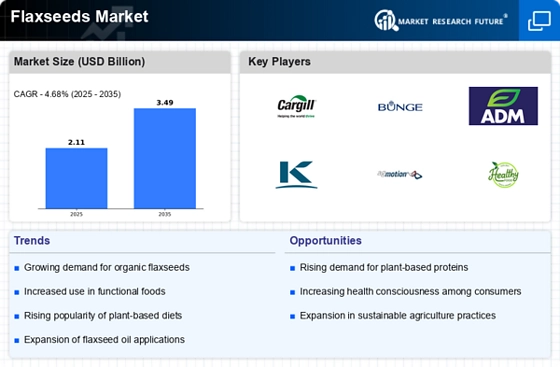Innovations in Food Products
The Flaxseeds Market is witnessing a surge in innovations related to food products that incorporate flaxseeds. Manufacturers are increasingly developing a variety of items, such as flaxseed oil, protein powders, and fortified snacks, catering to diverse consumer preferences. This trend is supported by Market Research Future indicating that the demand for functional foods is on the rise, with consumers seeking products that offer health benefits beyond basic nutrition. The introduction of new and convenient flaxseed-based products is likely to attract a broader audience, including those who may not traditionally consume flaxseeds. As a result, the Flaxseeds Market is poised for growth as it adapts to changing consumer needs and preferences.
Expansion of E-commerce Platforms
The expansion of e-commerce platforms is transforming the Flaxseeds Market by providing consumers with greater access to flaxseed products. Online shopping has become increasingly popular, allowing consumers to conveniently purchase a wide range of flaxseed-based items from the comfort of their homes. This trend is supported by data indicating that online grocery sales are on the rise, with more consumers opting for digital shopping experiences. E-commerce platforms also enable niche brands to reach a broader audience, enhancing competition within the Flaxseeds Market. As more consumers turn to online channels for their shopping needs, the Flaxseeds Market is likely to see increased sales and market penetration.
Nutritional Awareness and Education
Increased nutritional awareness among consumers is significantly influencing the Flaxseeds Market. As individuals become more informed about the health benefits associated with flaxseeds, including their potential to lower cholesterol and improve digestive health, demand is expected to rise. Educational campaigns and initiatives by health organizations are contributing to this trend, highlighting the importance of incorporating flaxseeds into daily diets. Market data indicates that consumers are actively seeking out foods rich in fiber and essential fatty acids, which positions flaxseeds favorably within the health food segment. This heightened awareness not only drives sales but also encourages manufacturers to innovate and develop new flaxseed-based products, further expanding the Flaxseeds Market.
Sustainability Trends in Agriculture
Sustainability trends in agriculture are increasingly impacting the Flaxseeds Market. As consumers become more environmentally conscious, there is a growing preference for sustainably sourced and produced food items. Flaxseeds, known for their low environmental impact compared to other crops, are gaining traction among eco-conscious consumers. The cultivation of flax requires fewer resources, such as water and fertilizers, making it an attractive option for sustainable farming practices. Market data suggests that consumers are willing to pay a premium for products that align with their values regarding sustainability. This trend is likely to drive growth in the Flaxseeds Market as producers emphasize eco-friendly practices and promote the environmental benefits of flaxseed cultivation.
Rising Demand for Plant-Based Products
The Flaxseeds Market is experiencing a notable increase in demand for plant-based products, driven by a growing consumer preference for healthier dietary options. As more individuals adopt vegetarian and vegan lifestyles, the incorporation of flaxseeds into diets is becoming more prevalent. Flaxseeds are recognized for their high omega-3 fatty acid content, which is essential for heart health. According to recent data, the plant-based food sector is projected to grow significantly, with flaxseeds playing a crucial role in this trend. This shift towards plant-based nutrition not only supports health-conscious consumers but also aligns with broader dietary trends that emphasize natural and unprocessed foods. Consequently, the Flaxseeds Market is likely to benefit from this sustained interest in plant-based alternatives.

















Leave a Comment